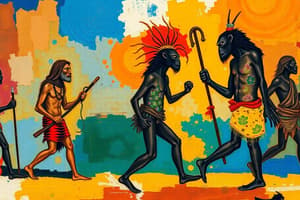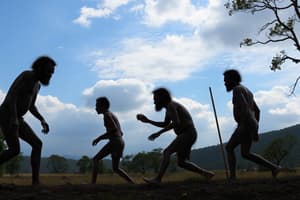Podcast
Questions and Answers
What is the term used to describe the process of human evolution from the oldest ancestors to present-day humans?
What is the term used to describe the process of human evolution from the oldest ancestors to present-day humans?
- Hominization (correct)
- Evolutionization
- Species transformation
- Primate development
What led to the evolution of Australopithecus from the Northwest African primates?
What led to the evolution of Australopithecus from the Northwest African primates?
- Climate change
- Genetic mutations
- Dietary changes
- Migration to the plains (correct)
What was a significant physical change in Homo habilis compared to Australopithecus?
What was a significant physical change in Homo habilis compared to Australopithecus?
- Development of a tail
- Brain size reduction
- Brain size increase (correct)
- Loss of ability to walk upright
What was a major innovation of Homo erectus?
What was a major innovation of Homo erectus?
What was a characteristic of Homo sapiens that distinguished them from earlier species?
What was a characteristic of Homo sapiens that distinguished them from earlier species?
Where did Homo erectus migrate to from Africa?
Where did Homo erectus migrate to from Africa?
What was a significant advantage of Homo sapiens over earlier species?
What was a significant advantage of Homo sapiens over earlier species?
What is the current stage of human evolution?
What is the current stage of human evolution?
Flashcards are hidden until you start studying
Study Notes
Human Evolution
- Human evolution began over 6 million years ago and involved a series of stages and changes from the oldest ancestors to present-day humans.
- This process is known as hominization, which transformed the species to differ from all others on Earth.
Early Stages
- A population of Northwest African primates split into two groups, with one staying in the trees and the other migrating to the plains.
- The migrating group learned to stand on their forelegs, freeing their hind legs to eventually become hands.
- These primates, known as Australopithecus, started collecting fruits, hunting, and adapting to their environment.
Homo Habilis
- Australopithecus evolved into Homo habilis due to factors like climate change.
- Homo habilis created instruments for survival, walked upright, and manufactured stone utensils.
- Their brain was twice as large as that of Australopithecus.
Homo Erectus
- Homo erectus was the first to leave Africa and migrate to Asia.
- They had more capacity than Homo habilis, creating more complex stone instruments and covering their bodies with animal skins.
- They walked upright, discovered fire, and developed social coexistence, gathering in groups to survive.
Homo Sapiens
- Homo sapiens, also known as Modern Man, spread throughout the land, leaving behind instruments of stone, bone, and ivory.
- They developed painting, sculpture, and had a well-developed brain, allowing them to create, invent, and learn.
- They improved communication with others, using speech and more.
Present-Day Humans
- The last evolutionary stage resulted in physically modern humans, who developed their thinking and improved their abilities.
- Humans evolved from apes to become the most extraordinary and intelligent beings on the planet.
Human Evolution
- Human evolution started over 6 million years ago and involved multiple stages of transformation from ancient ancestors to present-day humans.
Early Stages
- A population of Northwest African primates divided into two groups, with one remaining in trees and the other migrating to plains.
- The migrating group adopted upright posture on all fours, freeing their hind legs to eventually become hands.
- They became Australopithecus, adapting to their environment by collecting fruits, hunting, and gathering.
Homo Habilis
- Australopithecus evolved into Homo habilis due to factors like climate change.
- Homo habilis developed instruments for survival, manufacturing stone utensils, and walked upright.
- Their brain size doubled compared to Australopithecus.
Homo Erectus
- Homo erectus was the first to migrate from Africa to Asia.
- They had a larger brain capacity than Homo habilis, creating more complex stone instruments.
- They walked upright, discovered fire, developed social coexistence, and wore animal skins for protection.
Homo Sapiens
- Homo sapiens, or Modern Man, spread across the land, leaving behind instruments of stone, bone, and ivory.
- They developed painting, sculpture, and had a highly developed brain, enabling creativity, invention, and learning.
- They improved communication with others, using speech and more.
Present-Day Humans
- The final evolutionary stage resulted in physically modern humans, who developed their thinking and abilities.
- Humans evolved from apes to become the most intelligent and extraordinary beings on Earth.
Studying That Suits You
Use AI to generate personalized quizzes and flashcards to suit your learning preferences.




